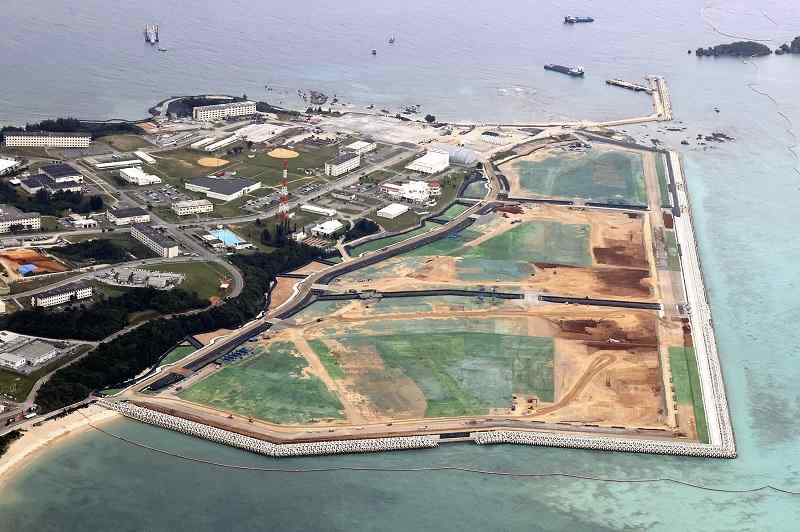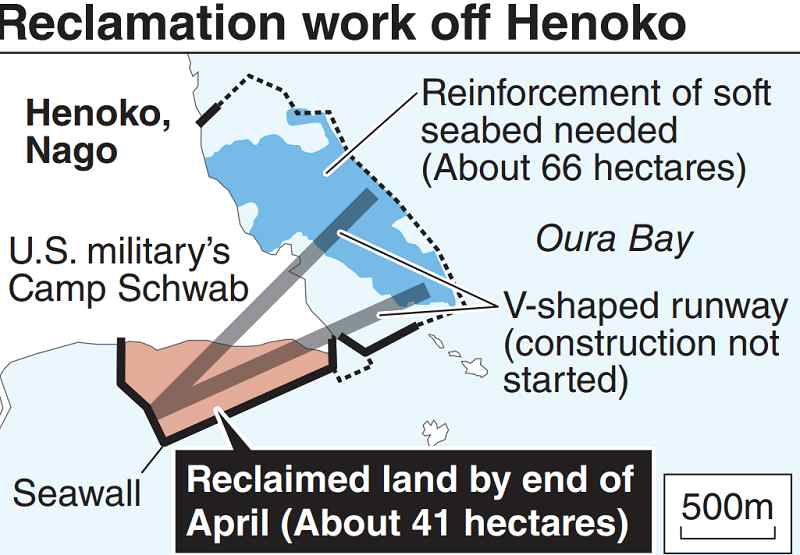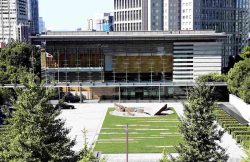
The coastal area of the Henoko district in Nago, Okinawa Prefecture, is seen on April 9.
12:22 JST, April 14, 2021

Monday marked 25 years since the Japanese and U.S. governments reached an agreement for the return of the U.S. Marine Corps’ Futenma Air Station in Ginowan, Okinawa Prefecture, to Japan.
Land reclamation work is underway in the coastal area of the Henoko district of Nago in the prefecture, where the air station will be relocated.
The government has applied to the prefecture for approval for ground reinforcement work as soft ground was discovered in the north of the planned sea area, but the prefectural government, which opposes the relocation, is attempting to obstruct the work.
If the situation develops into a lawsuit between the central government and the prefecture, the central government’s goal of completing the relocation in the 2030s may be delayed.
The government is in a hurry to finish the land reclamation work because the completion of the relocation is a precondition for the return of the Futenma base, which is said to be “the most hazardous in the world.”
However, the prefectural government has maintained its stance of blocking the relocation. The longer the construction work is delayed, the more likely it is that the situation in Futenma will get bogged down.
‘Established fact’
Chief Cabinet Secretary Katsunobu Kato stressed the significance of the relocation at a press conference on Monday, saying, “Steady progress in the construction will lead to the elimination of hazards linked to Futenma Air Station.”
After the inauguration of the second administration of former Prime Minister Shinzo Abe in 2012, it pledged to link the base issue with measures for Okinawa Prefecture’s development in an attempt to break down the opposition camp. Then Chief Cabinet Secretary Yoshihide Suga led the efforts.
In Nago, where the mayor was an opponent of the relocation, Suga took the unusual step of providing funding directly to the three local districts near the planned relocation area to sway them.
Disaster mitigation stockpiling facilities and other facilities were built and the candidate supported by the ruling Liberal Democratic Party and Komeito won the 2018 mayoral election.
About a quarter of the planned Henoko relocation zone on the southern side has been reclaimed, and “the relocation has become an established fact,” according to a government source.
Regarding the soft seabed on the north side, about 71,000 piles made of sand and other materials will need to be driven into the seabed to reinforce the ground. This method was used in the construction of Kansai International Airport, and Defense Ministry officials are confident that it can be done.
Leadership declining
Okinawa Gov. Denny Tamaki is poised to refuse to approve the ground reinforcement work. The government plans to counter with lawsuits and proceed with the work even if the approval is not given.
The influence of the multipartisan “all-Okinawa” group, which had supported the governor, is waning as right-leaning members are opposed to the governor’s increasingly liberal stance.
Tamaki has lost a series of lawsuits against the central government over the relocation of the base, and he is unable to find an effective countermeasure other than stalling for time by using his licensing authority.
Prime Minister Suga has contacted the local business community and other parties attempting to drive a wedge between them and Tamaki in preparation for the 2022 gubernatorial election.
More takeoffs, landings
As China’s military threat has intensified, the presence of U.S. troops in Okinawa has become even more important as a deterrent.
The number of takeoffs and landings at the Futenma base, where the U.S. Marines are based, has increased in recent years as its strategic importance has grown, reaching 16,883 at the end of February in fiscal 2020. Hazard risks linked to the air station are increasing in bordering residential areas, according to a Defense Ministry source.
Meanwhile, little by little, progress has been made in reducing the burden of hosting U.S. bases in Okinawa. A municipal road was opened to all traffic in a section of the Futenma base that was returned to Japan in July 2017, and it is expected to ease traffic congestion on surrounding roads.
To reduce the burden on the prefecture while maintaining the deterrent, the government plans to steadily proceed with construction and procedures to realize the relocation of the U.S. base.
"Politics" POPULAR ARTICLE
-

Japan to Support Central Asian Logistics Route That Bypasses Russia, Plan to Be Part of Upcoming Summit in Tokyo
-

Japan to Tighten Screening of Foreigners’ Residential Status by Providing Information of Nonpayment of Taxes
-

Takaichi Cabinet Approval Holds at 72% as Voters Back Aggressive Fiscal Stimulus, Child Benefits
-

Chinese, Russian Bombers Flew Unusual Path by Heading Toward Tokyo; Move Likely Meant to Intimidate Japan
-

Takaichi Meets Many World Leaders at G20 Debut in Johannesburg; Speaks with Heads of Countries Including Italy, U.K., Germany, India
JN ACCESS RANKING
-

Keidanren Chairman Yoshinobu Tsutsui Visits Kashiwazaki-Kariwa Nuclear Power Plant; Inspects New Emergency Safety System
-

Imports of Rare Earths from China Facing Delays, May Be Caused by Deterioration of Japan-China Relations
-

University of Tokyo Professor Discusses Japanese Economic Security in Interview Ahead of Forum
-

Japan Pulls out of Vietnam Nuclear Project, Complicating Hanoi’s Power Plans
-

Govt Aims to Expand NISA Program Lineup, Abolish Age Restriction























